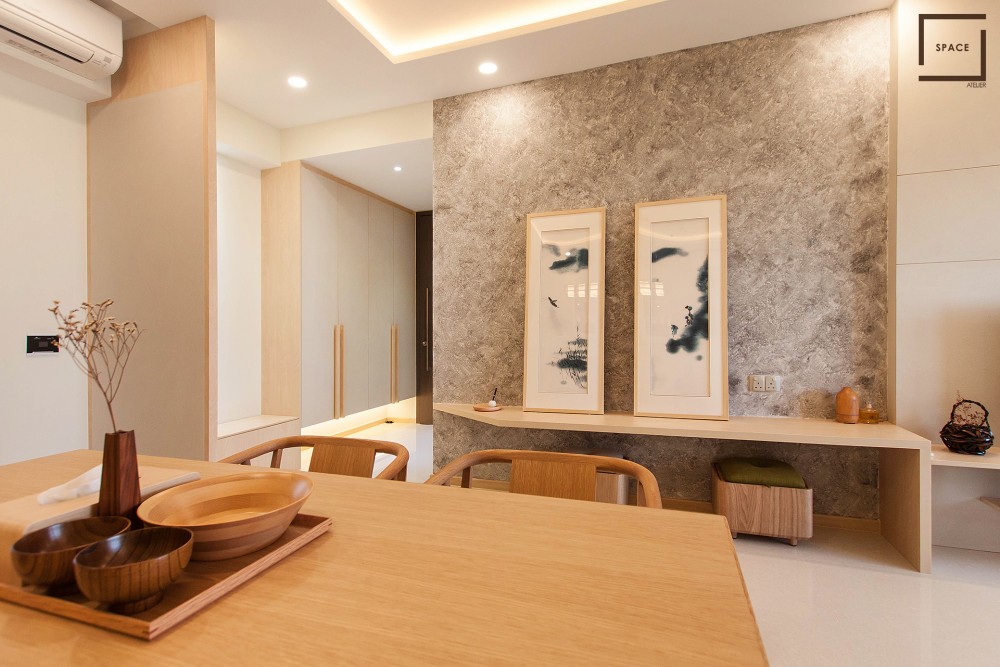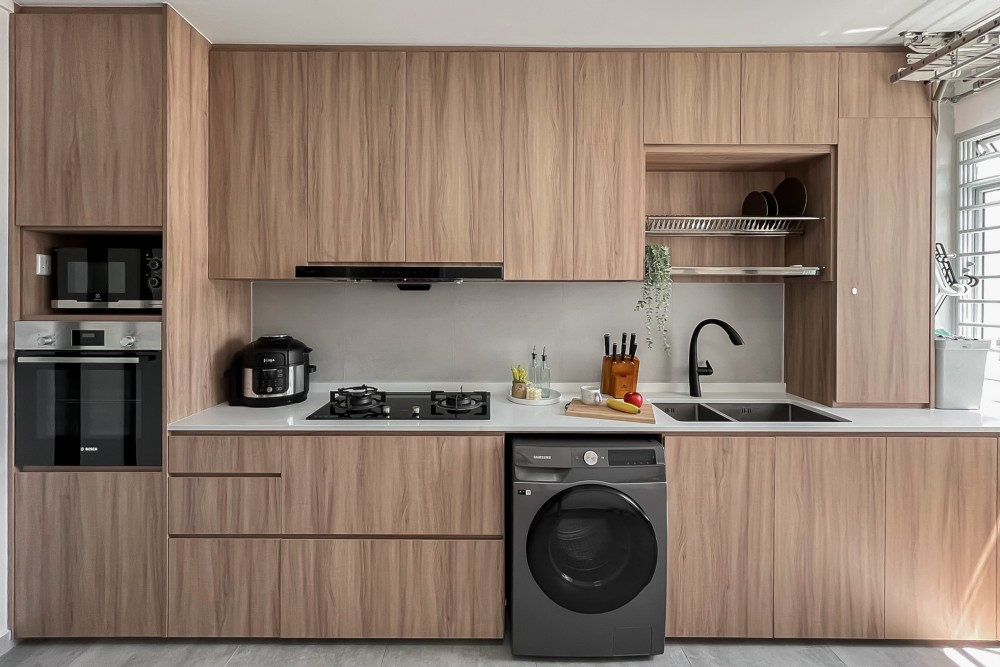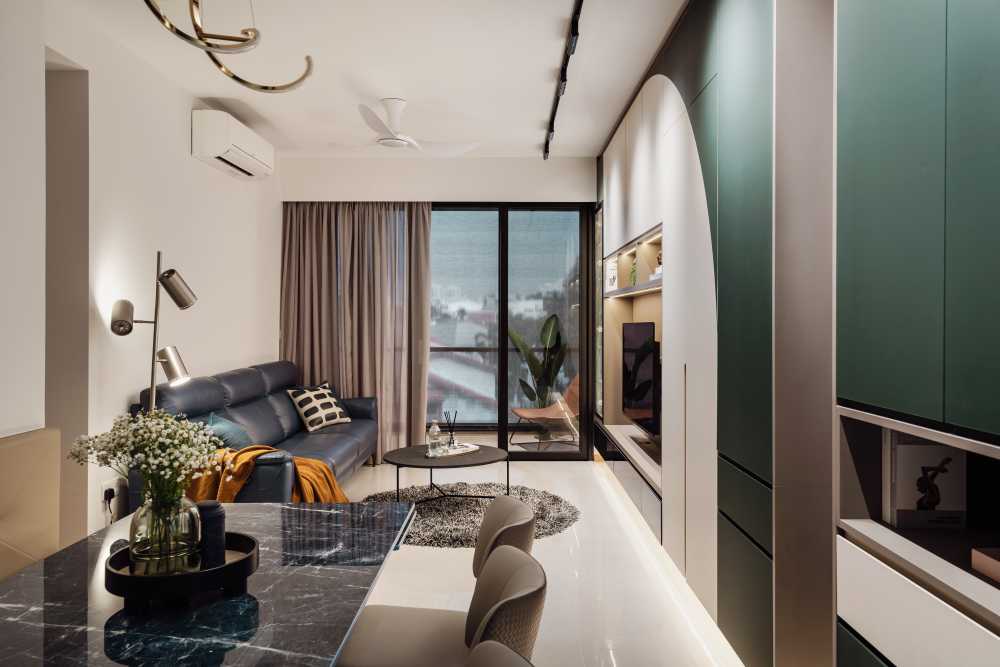How To Create A Home Gym In Singapore
Creating a home gym is an excellent way to stay fit and motivated.
You get the convenience of exercising within the comfort of your own home, and you can personalize your home gym to your needs.
In this comprehensive guide, we’ll walk you through how to create a home gym in Singapore, so that you have everything you need to achieve your fitness goals.
Let’s jump right in!
Why A Home Gym?
For those who are mulling over the idea of a home gym, but not 100% convinced, here’s why having a home gym is a good idea.
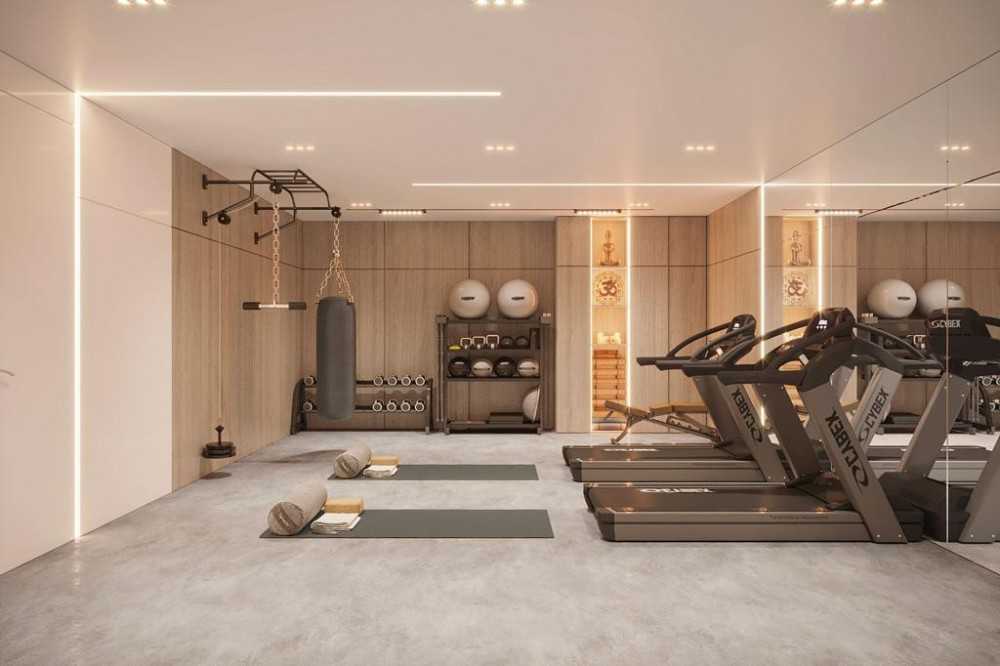

Landed @ Dalvey Road ($780,000) by Dots ‘N’ Tots Interior Pte Ltd
Firstly, it’s convenient.
One of the primary benefits of a home gym is the convenience it provides. You can exercise whenever you want, without being limited by gym hours or crowded facilities. With a home gym, you have the flexibility to fit workouts into your schedule, making it easier to stay consistent with your fitness routine.
Next, you can personalise your home gym.
Creating a home gym allows you to design a fitness environment that caters to your preferences and needs. You can customize the equipment, layout, and ambiance to create a space that improves your workout experience.
Next, there’s also the issue of privacy and comfort.
Working out in the privacy of your own home eliminates any self-consciousness or discomfort that may arise in a public gym setting. You can exercise freely, experiment with new exercises, and focus solely on your workout without distractions.
Privacy aside, there’s also the fact that you don’t need to wait or share equipment.
In a commercial gym, popular equipment may often be occupied, leading to waiting times or the need to modify your workout plan. Having a home gym eliminates this issue, because you’ll always have immediate access to all your equipment.
Finally, don’t forget about hygiene!
With a home gym, you have control over cleanliness and hygiene standards. You can maintain proper sanitization practices, ensuring a hygienic workout environment that meets your standards.
Is building a home gym cheaper than going to a commercial gym?
This really depends on what type of commercial gym you go to, as the prices of commercial gyms vary a lot.
First, let’s discuss the different tiers of gyms (and the associated prices) in Singapore:
#1: Most affordable gyms
Example: ActiveGYM™ (by ActiveSG)
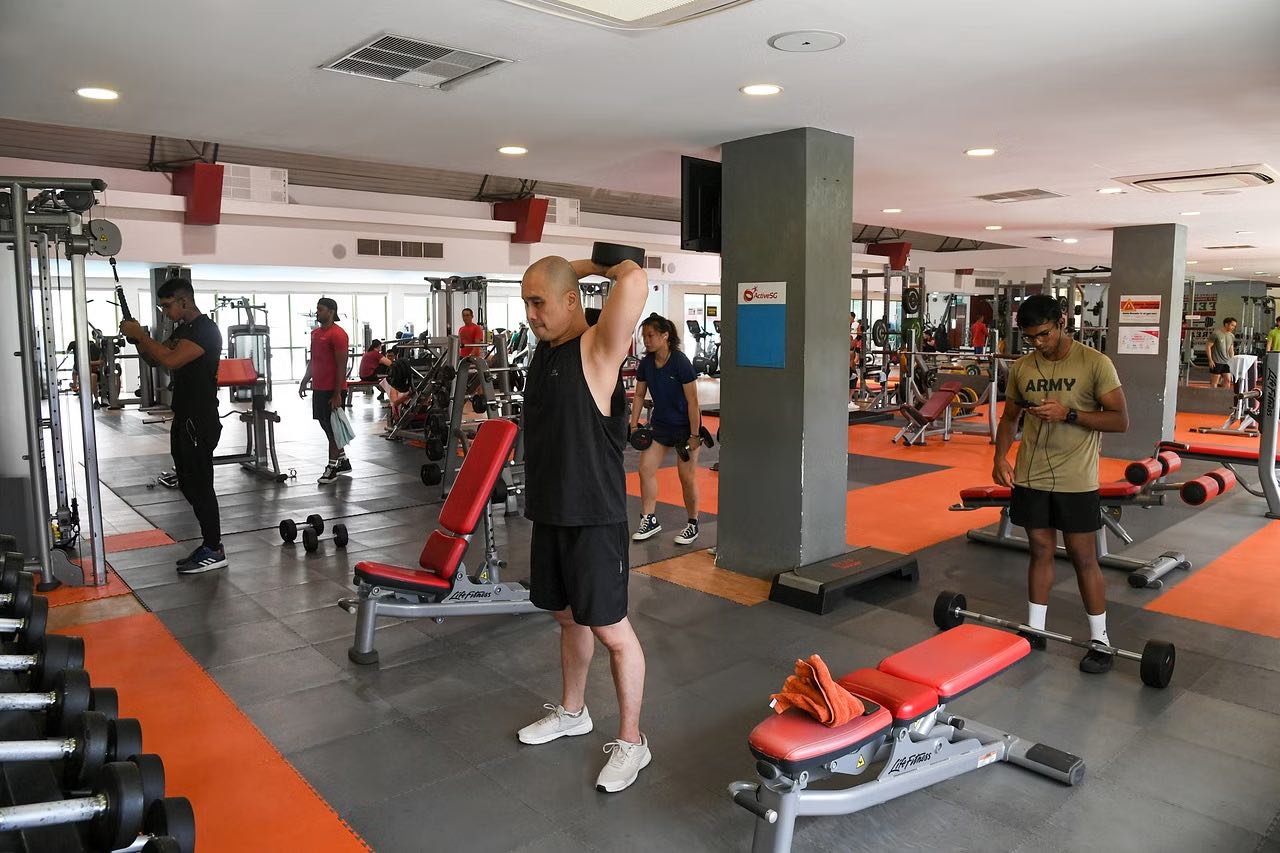

The most affordable gyms in Singapore are basically the ActiveGYM™ gyms – these charge only $2.50 per entry.
This can be an attractive option for anyone who’s budget conscious, but do note that these gyms are no-frills and do not provide the same level of amenities or services as other gym tiers.
#2: Mid-tier gyms
Example: Anytime Fitness
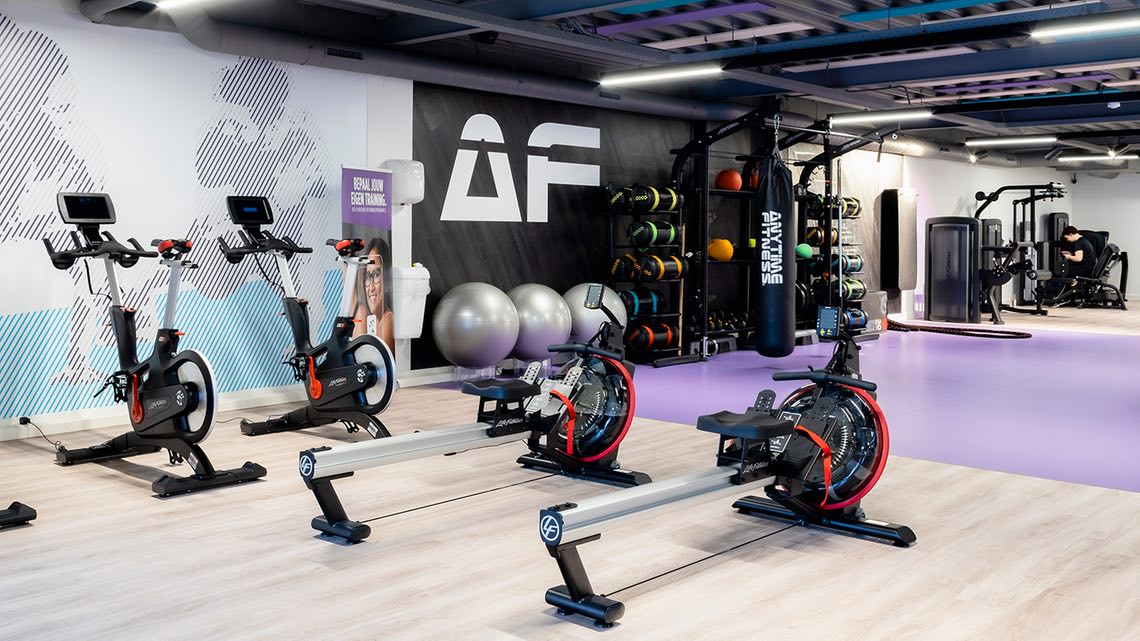

Mid-tier gyms like Anytime Fitness typically charge around $100 per month for a membership, although prices vary based on ongoing promotions.
These gyms often offer a good balance between cost and amenities. They do provide a decent range of equipment, but definitely have less classes (or in certain classes, no classes at all) compared to the higher end gyms.
#3: Higher-end gyms
Example: Virgin Active, PURE Gym
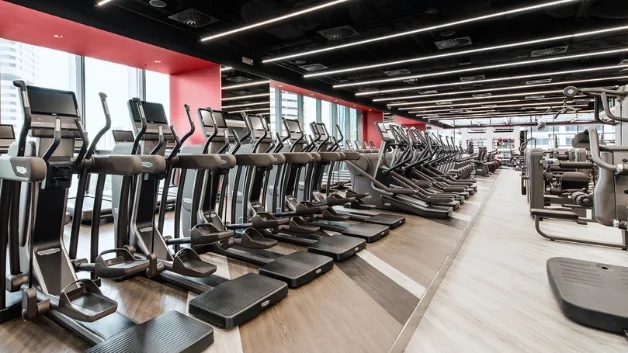

Sembawang Cres ($29,000) by Homies Design
Higher-end gyms like Virgin Active usually charge $200 or more per month for a membership (although you do get discounts if you sign up for a longer period of time).
These gyms often provide top-of-the-line equipment, a wide range of classes, dedicated personal trainers, and premium amenities.
Considering the above cost ranges, let’s now compare these figures with building a home gym, and calculate the break-even point.
Some assumptions:
- We’ll be adding in transport savings in our calculations, since gymming at home means that you don’t need to pay to get to the gym and back. For transport, we’ll go with a conservative estimate of $4 for a round trip (assuming you pay $2 for public transport to the gym, and $2 back).
- We’ll also work with the assumption that you gym 5x a week. This might sound like a lot, but realistically, we find that most people with home gyms do work out very frequently.
- Finally, we’ll assume that you’re spending $2,000 on your home gym. You can definitely get away with a smaller budget, but again, this is a conservative estimate!
Cheapest Gyms eg ActiveGYM™ (by ActiveSG):
Assuming the monthly fee for ActiveGYM™ is $50, and considering a round-trip transportation cost of $4 per visit, the break-even point would be 40 months ($2,000 / ($50 – $4) = 40 months).
This means it would take approximately 3 years and 4 months of working out at home in order to make your home gym worth it (assuming your next best alternative is to work out at an ActiveGYM™).
Mid-tier Gyms eg Anytime Fitness:
Assuming the monthly membership fee for mid-tier gyms like Anytime Fitness is $100, and considering a round-trip transportation cost of $4 per visit, the break-even point would be 20 months ($2,000 / ($100 – $4) = 20 months).
This means it would take approximately 1 year and 8 months of working out at home in order to make your home gym worth it (assuming your next best alternative is to work out at a mid-tier gym).
Higher-end Gyms eg Virgin Active:
Assuming the monthly membership fee for higher-end gyms like Fitness First is $200, and considering a round-trip transportation cost of $4 per visit, the break-even point would be 10 months ($2,000 / ($200 – $4) = 10 months).
This means it would take approximately 10 months of working out at home in order to make your home gym worth it (assuming your next best alternative is to work out at a high-end gym).
So there you have your answer!
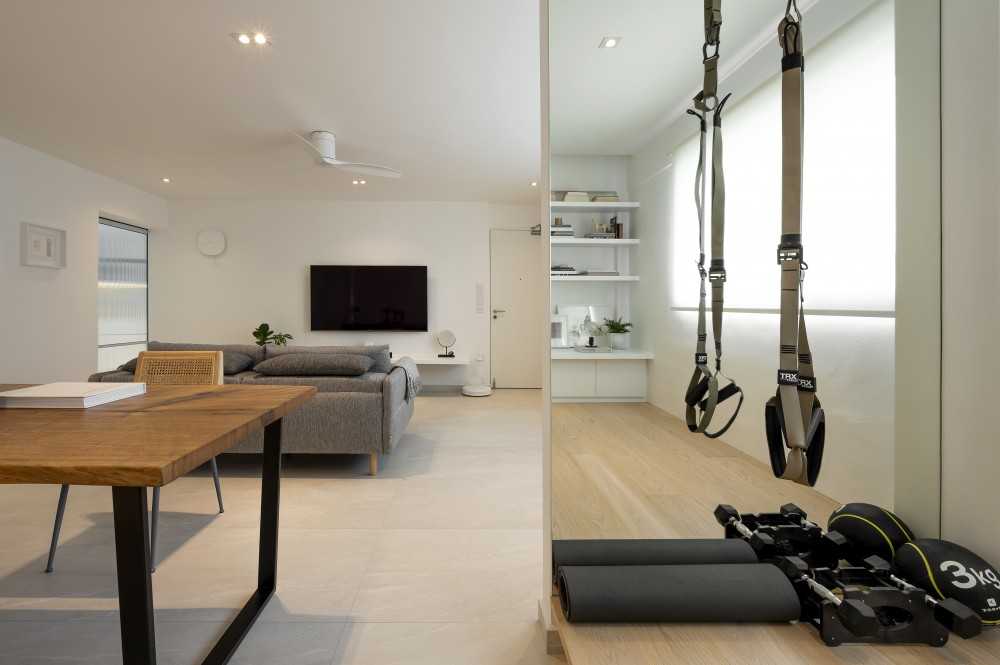

Ang Mo Kio ($82,000) by Le Interi Design
If you’re going to mid-tier gyms or expensive gyms, where you’re spending $100 or more per month on your gym membership, you start to see savings from your home gym pretty quickly (between 10 months to 1 year and 8 months).
But if you’re already saving money by going to an affordable gym, then setting up a home gym won’t help you save that much. It will take 3 years++ of gymming at home in order to make your setup worth it.
Of course, this is based on the assumption that there’s only 1 person using the home gym.
If you have 2 people who use the home gym, then this vastly shortens the breakeven point, and you start reaping the benefits of your home gym a lot faster.
Step 1: Assess Your Space
Before embarking on your home gym project, it’s essential to assess the available space in your home and choose the right space.
Firstly, evaluate the available area in your home that can be dedicated to your home gym.
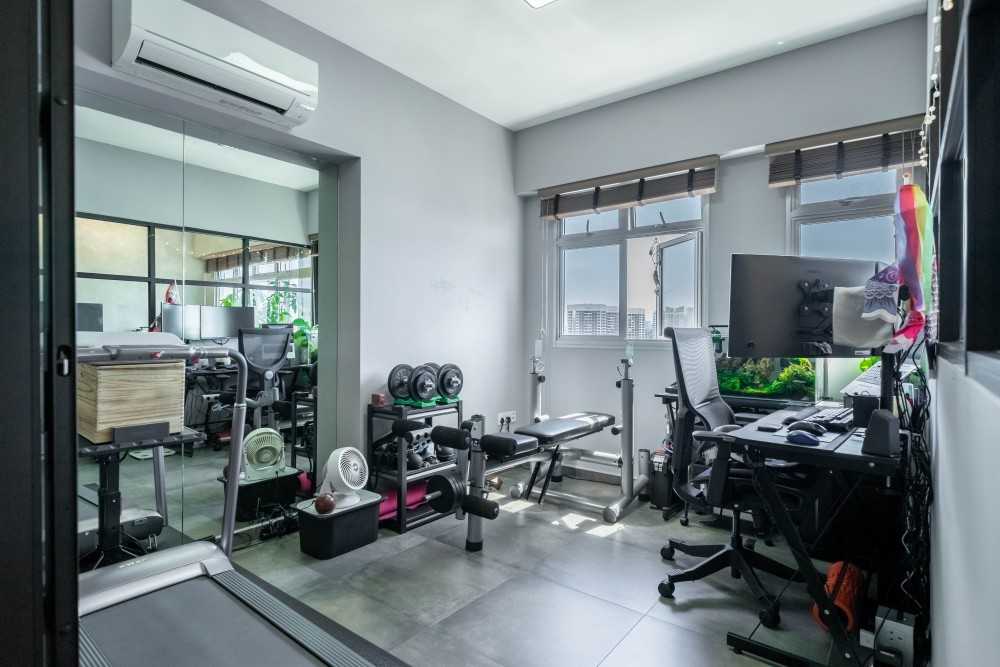

Kallang | St George Tower ($56,000) by Design 4 Space Pte Ltd
Consider factors such as room size, ceiling height, and ventilation, and ensure that there is enough space to accommodate the equipment you plan to include in your home gym setup.
If you have a spare room, balcony, or even a designated area in your living room, assess whether it can provide adequate space for your fitness activities without feeling cramped.
Do also check the ceiling height of the selected area – it’s essential to have enough clearance above your head, particularly for exercises that involve overhead movements like shoulder presses or skipping rope.
As a general guideline, a minimum ceiling height of around 2.4m is recommended, but more is preferable to ensure comfortable and safe workouts.
You also want to ensure proper ventilation in your chosen home gym space.
Good airflow helps regulate temperature, reduce moisture buildup, and maintain a comfortable workout environment. If possible, select a space with windows or install fans or air conditioning to keep the area well-ventilated during workouts.
Step 2: Set A Budget
Once you’ve assessed your space, the next thing you want to do is set a budget.
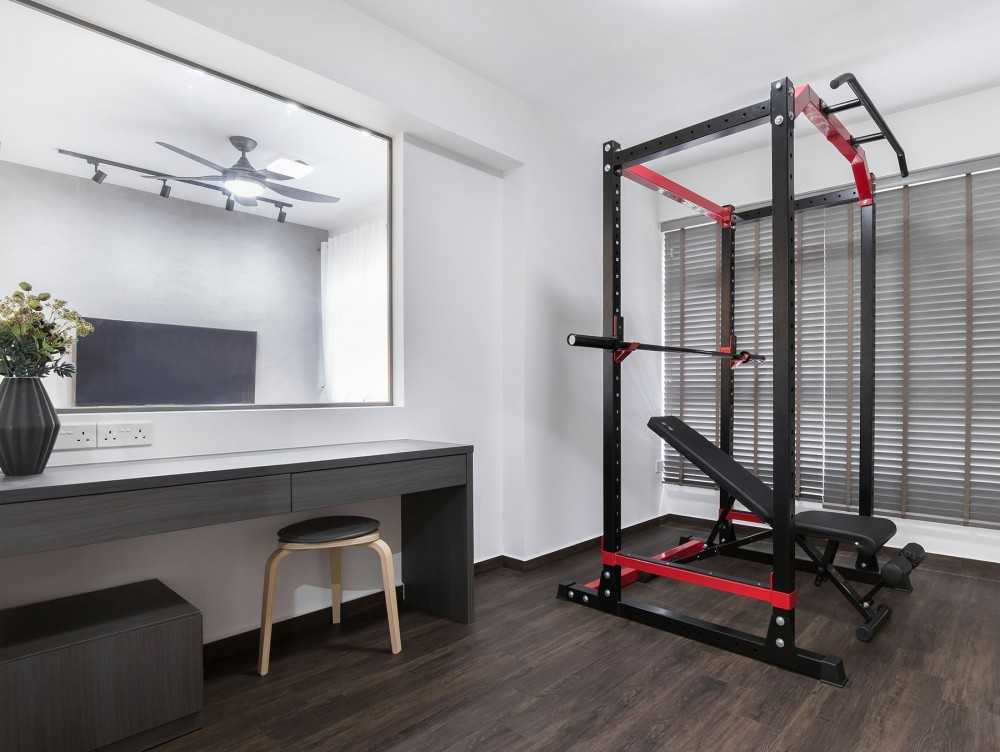

HDB Sunshine Court ($46,000) by U-Home Interior Design Pte Ltd
Determine how much you are willing to invest in equipment, flooring, mirrors, and any additional accessories or modifications. Having a budget in mind will guide your purchasing decisions and ensure that you stay within your financial means.
Remember to do thorough research on equipment prices, compare options, and take advantage of sales or second-hand options to maximize your budget.
If you’re trying to save money on equipment, one way of doing so is to select versatile equipment that allows you to perform multiple exercises.
For instance, adjustable dumbbells or resistance bands can provide a variety of resistance levels and exercises in a compact form. This helps maximize your space and reduces the need for purchasing multiple individual pieces of equipment.
You can also DIY your own equipment. For example, make your own sandbags by filling sturdy bags with sand or rice, or use water jugs as makeshift weights. Look for creative solutions online that utilize household items or inexpensive materials to create workout equipment.
Step 3: Decide What Equipment To Get
In an ideal world, you’ll have a fully kitted-out home gym with all the equipment that you see in the commercial gyms.
However, that’s not realistic for most folks, who have to work with both budget and space constraints.
So how do you decide what equipment to get for your home gym?
Simple – identify your fitness goals, and go from there.
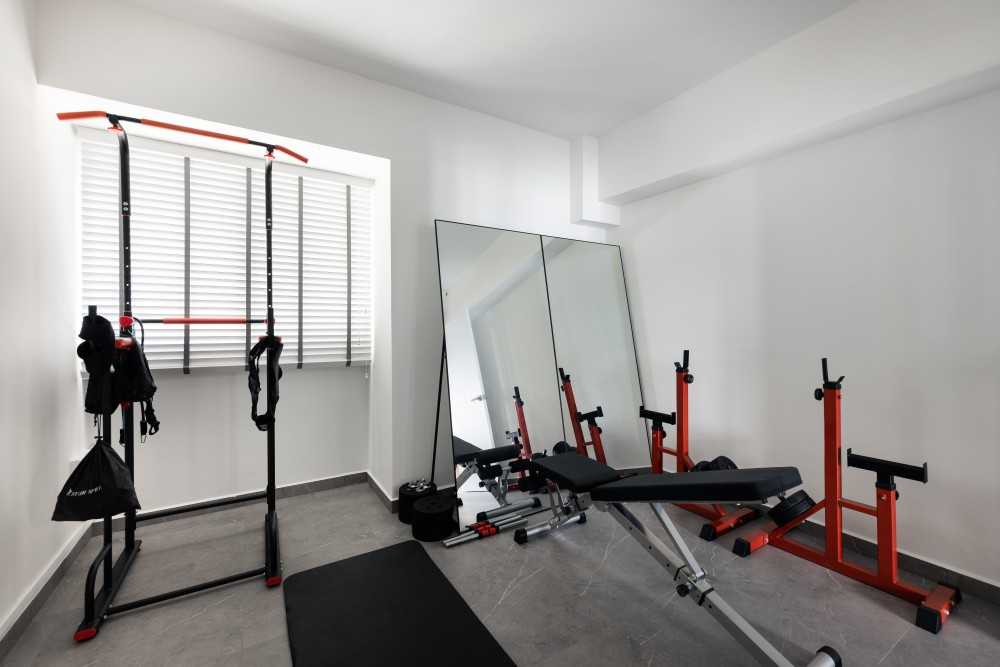

Woodlands Drive 14 ($70,000) by U-Home Interior Design Pte Ltd
Whether you’re focused on strength training, cardiovascular health, flexibility, or a combination of these, there are specific equipment options that align with each goal.
Strength Training
If your goal is to build strength and muscle, consider incorporating the following equipment into your home gym:
- Dumbbells: Versatile and essential for various exercises, dumbbells allow you to target specific muscle groups.
- Kettlebells: Ideal for functional training and compound movements that engage multiple muscle groups simultaneously.
- Resistance Bands: These bands provide adjustable resistance and are great for adding challenge to exercises and targeting specific muscles.
- Weight Bench: A weight bench allows for proper form and stability while performing exercises such as bench presses and step-ups.
- Pull-Up Bar: Perfect for upper body strength development, pull-up bars enable a variety of challenging exercises like pull-ups and chin-ups.
Cardiovascular Health
For improving cardiovascular health and endurance, consider the following equipment options:
- Treadmill: A treadmill offers the convenience of indoor running or walking, allowing you to control speed, incline, and intensity.
- Elliptical Trainer: Provides a low-impact cardiovascular workout, engaging both the upper and lower body.
- Stationary Bike: An excellent option for indoor cycling, offering a challenging cardio workout while minimizing joint impact.
- Jump Rope: A cost-effective and portable option that provides an effective cardiovascular workout and improves coordination.
Flexibility and Balance
If you aim to improve flexibility, balance, and overall mobility, include the following equipment in your home gym:
- Yoga Mat: Provides a comfortable surface for yoga, Pilates, and stretching exercises.
- Stability Ball: Helps improve core stability, balance, and flexibility through various exercises.
- Foam Roller: Ideal for self-myofascial release, it helps reduce muscle tension and improve flexibility.
- Resistance Bands: Apart from strength training, resistance bands can be used for stretching and improving flexibility.
Step 4: Plan Your Layout
Once you’ve decided on your equipment, it’s time to plan the layout of your home gym.
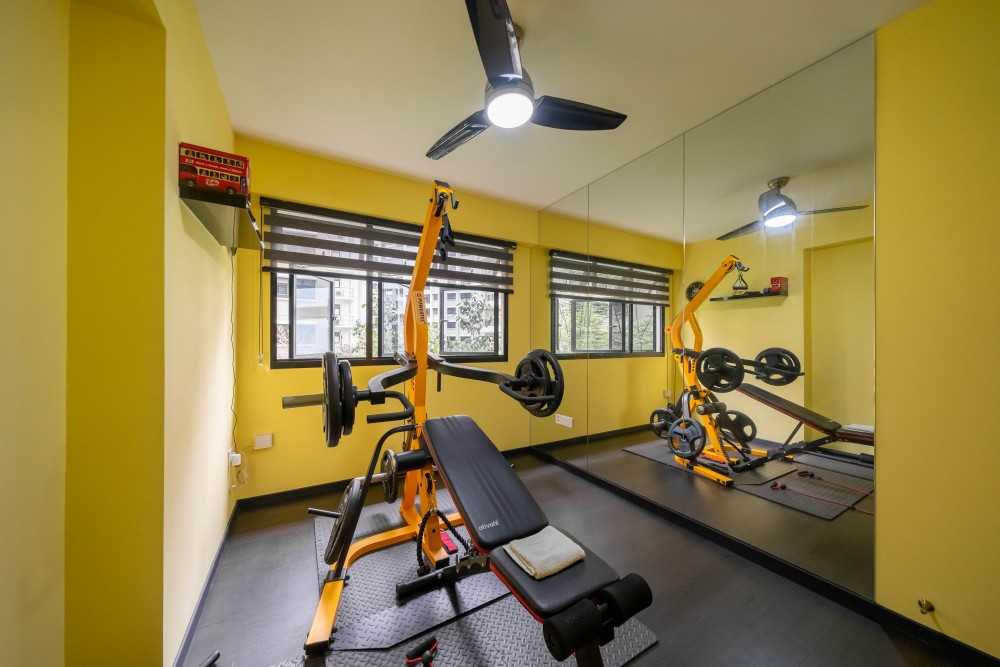

Buangkok | Buangkok Edgeview ($60,000) by Design 4 Space Pte Ltd
Here’s what you should do:
- Sketch a floor plan
- Figure out equipment placement
- Think about space & flow
- Add mirrors and storage
- Keep safety in mind
First, sketch a floor plan.
Start by sketching a floor plan of your home gym area. Measure the dimensions of the space and use graph paper or online tools to create a scaled representation. This will allow you to visualize and allocate the available space effectively.
Next, figure out equipment placement.
Consider the size and dimensions of your equipment when deciding on their placement. Place larger equipment such as treadmills or weight benches along the walls to maximize space. Ensure there is enough clearance around each piece of equipment to perform exercises comfortably and safely. Leave ample room for movement and transition between exercises.
Next, think about space and flow.
Plan the layout in a way that promotes a smooth flow of movement within your home gym. Ensure that there are no obstructions or cramped spaces that could impede your workouts. Leave enough space between equipment to allow for easy navigation and access.
Next, add mirrors and storage.
If space allows, consider incorporating mirrors into your home gym. Mirrors not only serve as a functional tool for checking your form, but can also make the space feel more open and spacious.
Additionally, think about storage solutions for equipment, accessories, and workout gear. Shelving units, storage racks, or designated storage areas can help keep your gym organized and clutter-free.
Finally, keep safety in mind.
Keep equipment away from potential hazards such as sharp corners, loose cables, or uneven flooring. Install rubber mats or gym flooring to provide stability and protect your floors. If you have children or pets, consider implementing safety measures to prevent accidents, such as using equipment locks or creating designated workout zones.
You’ve Got Your Home Gym… Now, Use It!
With your home gym set up, it’s crucial to establish a workout routine and maintain consistency.
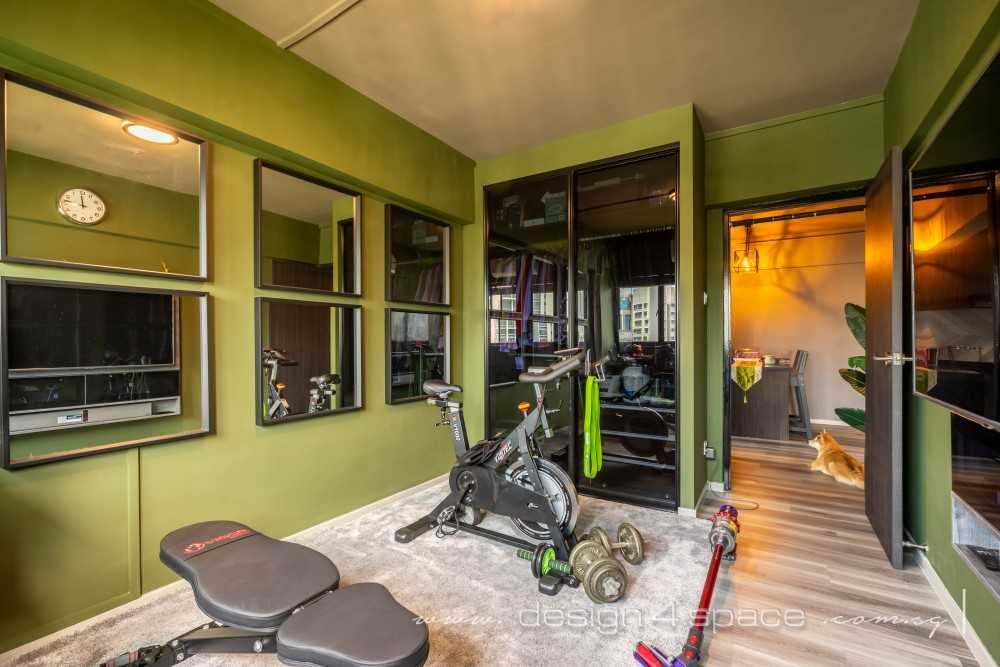

Potong Pasir | 104 Potong Pasir ($50,000) by Design 4 Space Pte Ltd
Here, create a schedule that suits your lifestyle and commitments, ensuring that you allocate dedicated time for your fitness activities.
It’s also a good idea to set achievable goals and track your progress regularly to stay motivated and monitor your improvement.
A Final Word On Creating A Home Gym In Singapore
The convenience of having a home gym allows you to exercise on your own terms, saving time and money in the long run.
Remember, consistency is key to achieving your fitness goals, so make sure to establish a routine and stay committed to your home gym journey.
Start building your dream fitness space today and enjoy the benefits of a healthier and more active lifestyle!
Want to check out home renovation projects for more inspiration? Browse home gym ideas on Hometrust, or click the button below to get connected with expert designers!
Renovating soon? Speak to top rated interior designers.
Discuss your home renovation ideas and plans with top rated firms, recommended by past homeowners. Let us help you shortlist the most suitable interior designers for your project.


